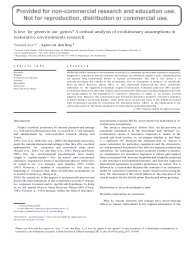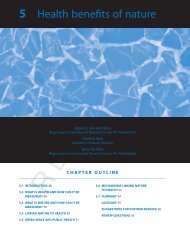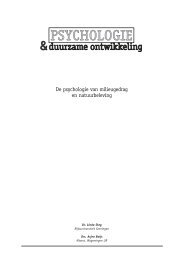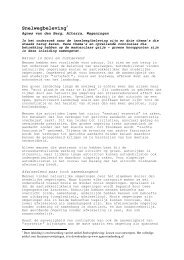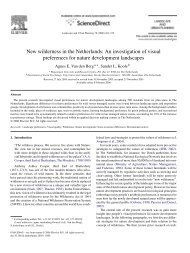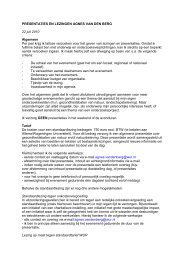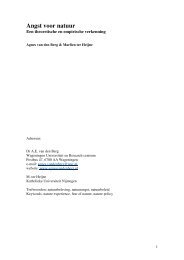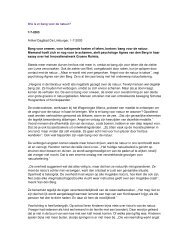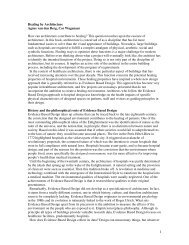healing environments in radiotherapy - Agnes van den Berg
healing environments in radiotherapy - Agnes van den Berg
healing environments in radiotherapy - Agnes van den Berg
Create successful ePaper yourself
Turn your PDF publications into a flip-book with our unique Google optimized e-Paper software.
Heal<strong>in</strong>g Environments <strong>in</strong> Radiotherapy Project Report<br />
Furthermore, uniform light<strong>in</strong>g that elim<strong>in</strong>ates shadows should be avoided, as shadows help def<strong>in</strong>e<br />
the three-dimensionality of items. Shadows make an environment ‘feel’ more natural, and therefore<br />
contribute to a sense of normality (Coalition for Health Environment Research, 2004). On the other<br />
hand, extreme shadows should be avoided because they might be disturb<strong>in</strong>g to patients and limit<br />
effectiveness of healthcare delivery (Mahnke, 1996).<br />
Light<strong>in</strong>g can also be used to enhance the natural, homely feel of the hospital. For example, St.<br />
Charles Medical Center uses <strong>in</strong>direct lightn<strong>in</strong>g, table lamps and shimmer<strong>in</strong>g lamps. This is the k<strong>in</strong>d of<br />
light<strong>in</strong>g you can f<strong>in</strong>d at home, which differs a lot from light<strong>in</strong>g at offices and public build<strong>in</strong>gs. The<br />
picture below shows a table lamp at UMC Gron<strong>in</strong>gen which comb<strong>in</strong>es elements of art and homely<br />
atmosphere (figure 10). In the mid 90s, fluorescent lamps that simulate natural daylight were<br />
advertised as a solution to <strong>in</strong>door light<strong>in</strong>g issues, supposedly enabl<strong>in</strong>g people to “feel better, be more<br />
alert, see better, and perform better” (Veitch, 1997). However, studies have as yet been unable to<br />
demonstrate positive effects of this so called full-spectrum light on mood (<strong>van</strong> <strong>den</strong> <strong>Berg</strong>, 2005).<br />
© KuiperCompagnions<br />
Figure 9: Artful table lamp at UMC Gron<strong>in</strong>gen<br />
Natural daylight, on the other hand, is often reported more beneficial than electric light for<br />
psychological comfort (Devl<strong>in</strong> & Arneill, 2003; Boyce et al., 2003). One study has shown that 73% of<br />
the respon<strong>den</strong>ts thought natural daylight was better for health than electric light<strong>in</strong>g (Heerwagen &<br />
Heerwagen, 1986; Van <strong>den</strong> <strong>Berg</strong>, 2005). Another study <strong>in</strong>dicates that patients who are exposed to<br />
<strong>in</strong>creased amounts of natural sunlight dur<strong>in</strong>g the recovery period after surgery experience less stress<br />
and pa<strong>in</strong>, use less analgesic medication, and produce less pa<strong>in</strong> medication costs (Walch et al., 2005).<br />
Besides, daylight also affects levels of alertness dur<strong>in</strong>g the day (Laurance, 2005). One expert, G.<strong>van</strong><br />
Lagen from Casa Terra, po<strong>in</strong>ts out that “there should be sufficient natural light from outside, so<br />
people do not feel locked up and can wander off with their eyes or thoughts”, which <strong>in</strong>dicates that<br />
the provision of natural daylight also has an added bonus of offer<strong>in</strong>g distraction for patients.<br />
14



